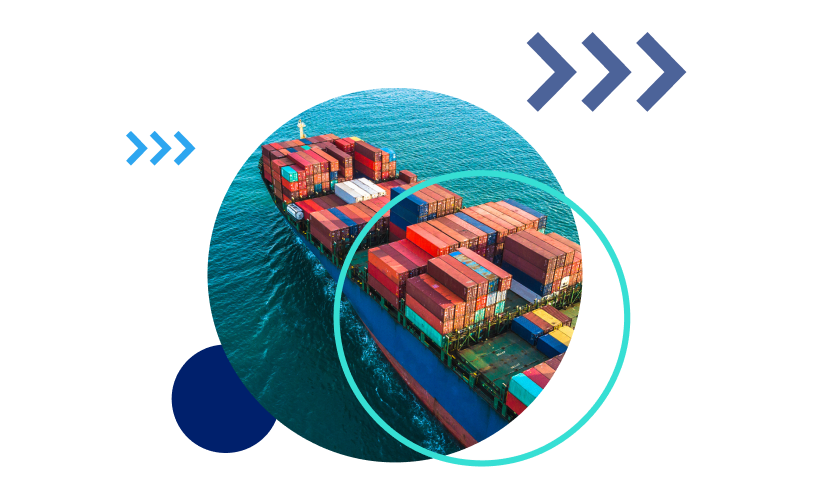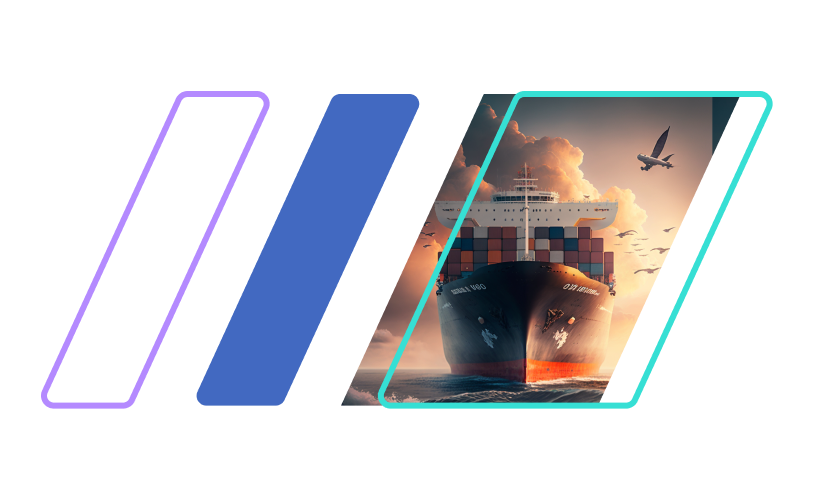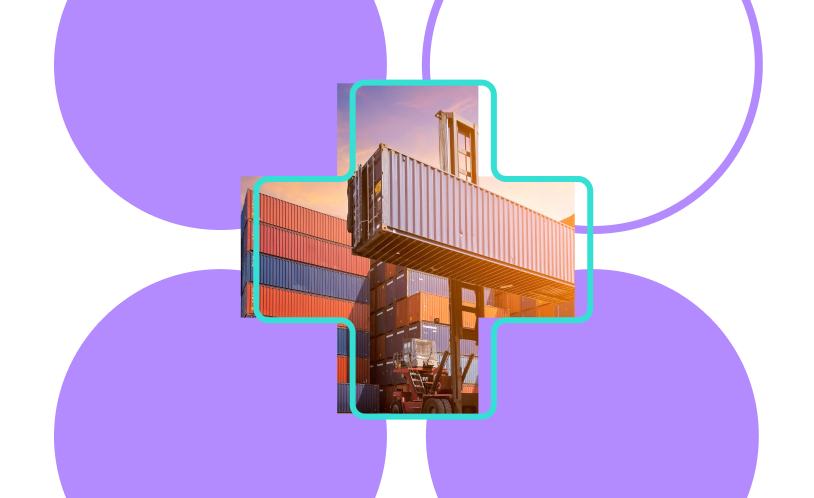Ship at high volumes? Ship large items like furniture, fragile ones like ceramics, or large, fragile ones like flat-screen TVs?
You are very likely an FCL shipper.
But that doesn’t mean everything about FCL is clear.
That’s why we consulted the experts and put together this guide to FCL. Read on to learn everything you need to know about shipping full containers.
FCL definition
FCL describes sea shipping for cargo loads large enough to fill a 20’ or 40’ shipping container.
Unlike LCL – less than a container load – where shipments share container space with other goods, FCL shipments use the entire container. That means the container is loaded and sealed at the factory and unloaded when it reaches the destination warehouse.
What does FCL stand for?
FCL stands for a full container load.
Looking for live quotes from vetted providers?
The benefits and drawbacks of shipping FCL
There are a number of benefits to shipping FCL:
- FCL shipments don’t need to be loaded and unloaded together with other shipments, which saves transit time.
- Sealing containers at the factory means less handling and fewer opportunities for damage.
- Price per unit on LCL is high, so for larger shipments, paying the FCL flat fee saves money.
- Air freight is the fastest way to ship. But if you have the time, you’ll save big choosing FCL instead.
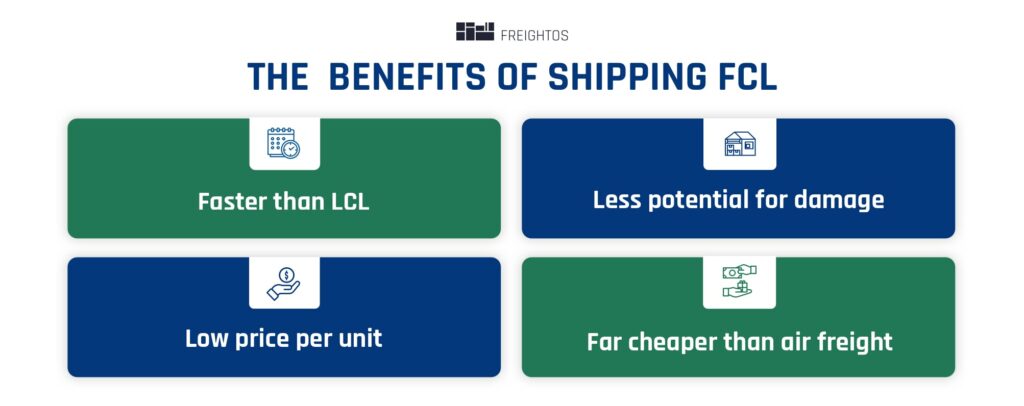
Here are some drawbacks of shipping FCL:
- Shipping larger quantities means finding and paying for more inventory space.
- For small loads (approximately 13 CBM or less) FCL will probably be more costly.
- Delivering a full container means you’ll need equipment and personnel that can handle the job, which not every factory has.
- When you ship FCL, delivery can get more complicated as you’ll be dealing with large shipments in small windows of time.
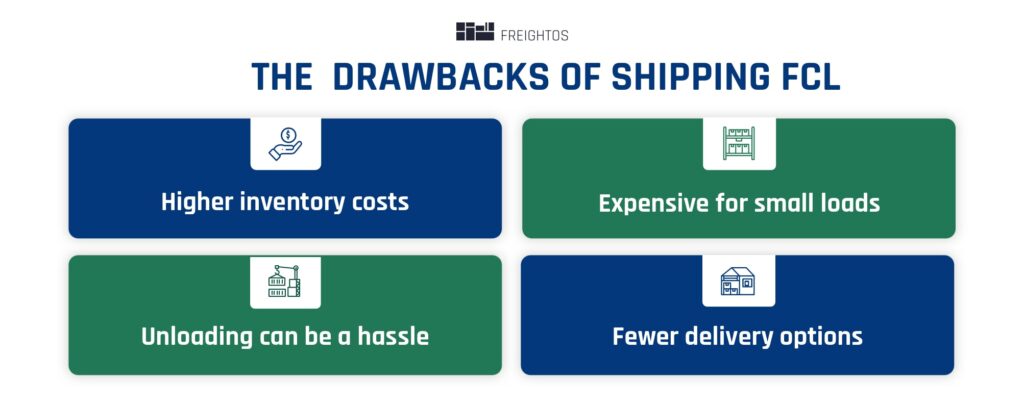
How much does it cost to ship a shipping container?
When you ship FCL, you pay a flat fee for the entire container, regardless of how much is in it.
But, once your shipment gets to be large enough – usually around 13 CBM, depending on your goods – it becomes well worth paying the flat fee because cost per unit on LCL is much higher.
Here are some other factors that affect FCL pricing:
- GRIs (General Rate Increases). These are container price increases that carriers can implement at the beginning and middle of each month, usually in response to demand. Learn more here.
- Peak season price spikes. Peak season hits when businesses ship at higher volumes to make sure their supply is ready for the holiday shopping season. For FCL, peak season is typically between August-November.
- Holiday delays. Shippers from China need to account for the Chinese New Year, usually in February, and Golden Week in fall, which are week-long holidays that impact demand and prices. Wherever your origin and destination, make sure to check the local calendar for important holidays.
FCL rates & prices year over year
Here’s an illustration of how FCL prices have changed over the past year:
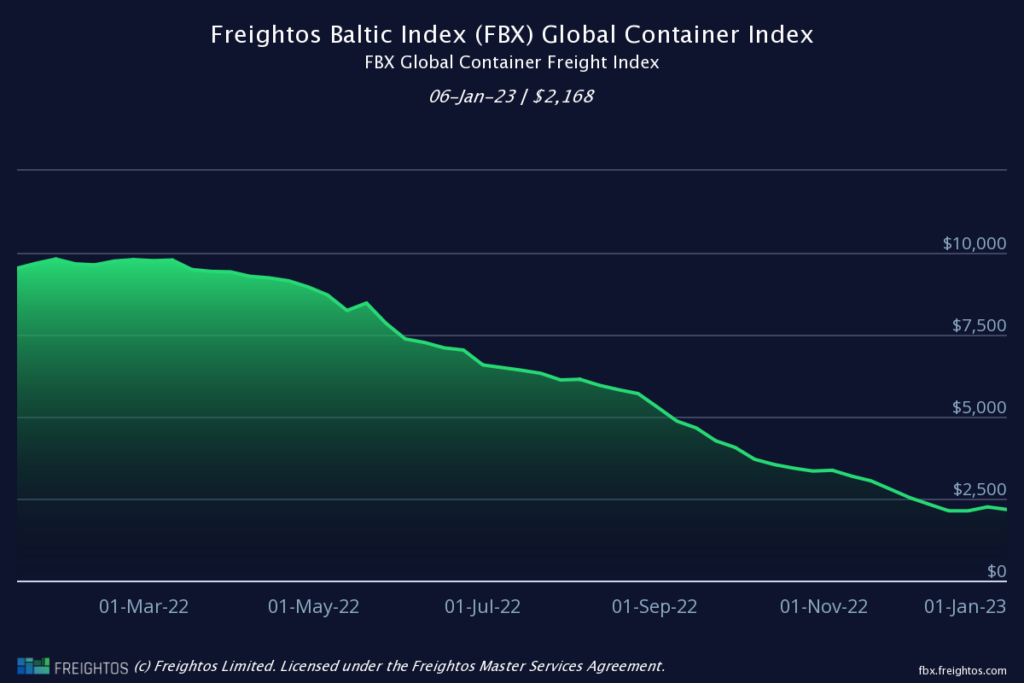
The above is an illustration of 40’ FCL prices. Notice that FCL prices have decreased dramatically since the start of 2022, after having skyrocketed since start of the pandemic. Container rates are down to pre-pandemic levels on many lanes. We will have to wait to see whether 2023 brings new surprises or whether price fluctuations will look more similar to typical pre-covid years with increases during largely predictable peak seasons.
It’s worth noting that LCL prices are not typically subject to the same price fluctuations as FCL, instead remaining largely stable throughout the year. This is mostly due to the fact that pricing structures for LCL and FCL are very different: in an FCL shipment, the majority of the cost comes from the actual sea journey, whereas for LCL, the most significant costs cover loading and unloading. That means that for LCL, actual freight price changes are not as impactful.
To learn about FCL price changes or get updates on pricing trends that could affect you, head on over to the Freightos Baltic Index.
Take the friction out of freight booking
Additional FCL costs & fees
FBA requirements
If you’re shipping to an Amazon FBA warehouse, make sure to account for a few things to minimize costs:
Labeling and palletization
Amazon has very strict requirements for packages that arrive at their warehouses. Your first step: make sure you know these requirements well. Next, decide on the most optimal way for your shipment to be labeled and palletized. You’ll want to have labeling done at the factory whenever possible.
As for palletizing, in many cases, it’s cheaper and more efficient to have your supplier palletize at the factory as long as your supplier knows the requirements. On the other hand, some shippers prefer to maximize container space by floor-loading their goods, and then palletizing after arrival at the destination port. Additionally, for FBA shipments to the US, there is a floor-loaded delivery option, which is much cheaper and less risky in terms of cargo damage than palletizing at destination.
You can price out these options in advance to decide what’s best for you.
Delivery
When you deliver a container to a US factory, Amazon requires you to schedule an appointment. The wait time for an appointment for a full container is typically longer than the wait time for LCL, which can end up costing you in demurrage and detention fees (see below for details on that). To avoid these fees, work with your forwarder to schedule your appointment well in advance. Also note that in some FBA warehouses in Europe, there is no option to deliver FCL shipments so it might be necessary to ship LCL. Additionally, some US FBA centers, especially in the Midwest, have difficulty handling FCL deliveries.
Customs Bonds
Anytime you ship to the US, you’ll need a Customs Bond. If you ship infrequently, you can opt for a single-entry bond. If you ship at higher volumes, consider an annual bond.
Duties and Taxes
Sometimes shippers can be caught off-guard by how much customs and taxes add to their total costs, so make sure to plan ahead. This is especially true if you are shipping from China and possibly subject to the tariffs implemented in the past several years.
You can estimate your customs costs using our free Import Duty calculator.
Demurrage and Detention
When your container arrives, there will be a period of time, usually four days in the US, when it can wait at the port free of charge. After this time, you will be charged a fee known as demurrage until you pick up your container. Demurrage charges vary by country, and in the US can turn into hundreds of dollars pretty quickly. Make sure your forwarder clears customs and collects the container from the port in a timely fashion.
Similarly, once your goods are picked up, you have a window of time until the container must be returned to the port, usually four days as well. After this, detention charges kick in, and like demurrage, they can add up fast.
There are also waiting time fees to consider. Typically, trucking companies allow 1-2 hours for the driver to wait for your container to be unloaded at the warehouse, and then charge additional fees by the hour.
Port Congestion Surcharge
If you ship to a popular port, you may end up with a congestion surcharge. That’s something to check with your freight forwarder when deciding on your destination port.
Expert tips for getting the best FCL pricing
If you’re shipping FOB, make sure to specify your origin port with your seller.
Shippers sometimes try to book FOB while providing only the origin country, and not the specific port – but prices can vary depending on your port. Specifying makes it more likely your price quote will be accurate.
Book well in advance of your pickup date.
As carrier space fills up, finding the best price becomes increasingly harder. Booking in advance gives you the best chance of getting the best price. Extra lead time is especially important during peak season.
Know your shipment’s precise weight.
If you know your shipment’s weight, you and your forwarder can determine what containers and equipment you’ll need, both for the sea journey and the inland trip to your factory. This is especially important because weight limits for sea vessels are not the same as weight limits for rail and trucking. The US, in particular, has tighter weight restrictions on inland trucking weights than Europe, and if you don’t plan for this, you might get hit with extra charges for special equipment.
“Any lack of information about weight has the same effect as buying a plane ticket and not realizing you have to pay for luggage – it’s not the experience you want.”
– Spencer Strader, ECU Director of Imports
Get important delivery information from your warehouse.
More specifically, find out:
- Is the warehouse dock height? That is, is the place where your container will be unloaded the same height as the dock and the truck? If extra maneuvering is necessary, there might be extra charges.
- Can the warehouse offload quickly? Longer deliveries can mean more fees.
Avoid shipping during peak season.
Prices go up, supply gets tight, and it’s harder to get your goods on time. Plan in advance as much as you can.
FCL shipment procedure

What is the procedure for delivery and unloading at my warehouse?
There are two types of warehouse deliveries: live and drop.
In a live unload, the container is unloaded while the driver waits. As we said above, there are usually 1-2 free hours allowed for a live unload.
Sometimes, when a warehouse is particularly busy, or lacks the necessary equipment to do a fast unload, you’ll want to do a drop. This means the driver drops the container off and picks it up again when unloading is complete, usually a day or two later.
Drop tends to be more expensive than live since it requires two trips by the driver. On the other hand, if you’re likely to have waiting time charges, drop could be the more affordable option. And sometimes, if the warehouse simply cannot unload the same day, drop is the only option.
For shippers who ship frequently enough, a drop-and-pick option might be a good one: drop off one container and pick up another, from a different shipment.
What paperwork will I need for my FCL shipment?
For the rundown on all the paperwork you’ll need to ship FCL, check out our key freight documents guide.
How long does FCL shipping take?
Shipping by FCL generally takes around 3-6 weeks, depending on your origin and destination.
Occasionally, shipments can get “rolled,” which means the container doesn’t get loaded onto the ship it was supposed to travel on, usually due to overbooked capacity.
To prevent rolled shipments to the extent possible, book in advance and make sure all your paperwork is in order.
Should I get a tender for FCL shipping?
If you ship more than 500 TEUs per year, it might be worth considering a tender, or annual shipping contract. To learn if tenders are right for you, check out our Guide to Shipping Contracts.
Is FCL right for me?
If you’re not sure if FCL is right for your shipping needs, or are debating between LCL or FCL, check out our Guide to LCL Shipping. We’ll run you through making the best decision for your shipment.
FCL container size and dimensions
Here are container dimensions for the two standard container sizes, 20′ and 40′:
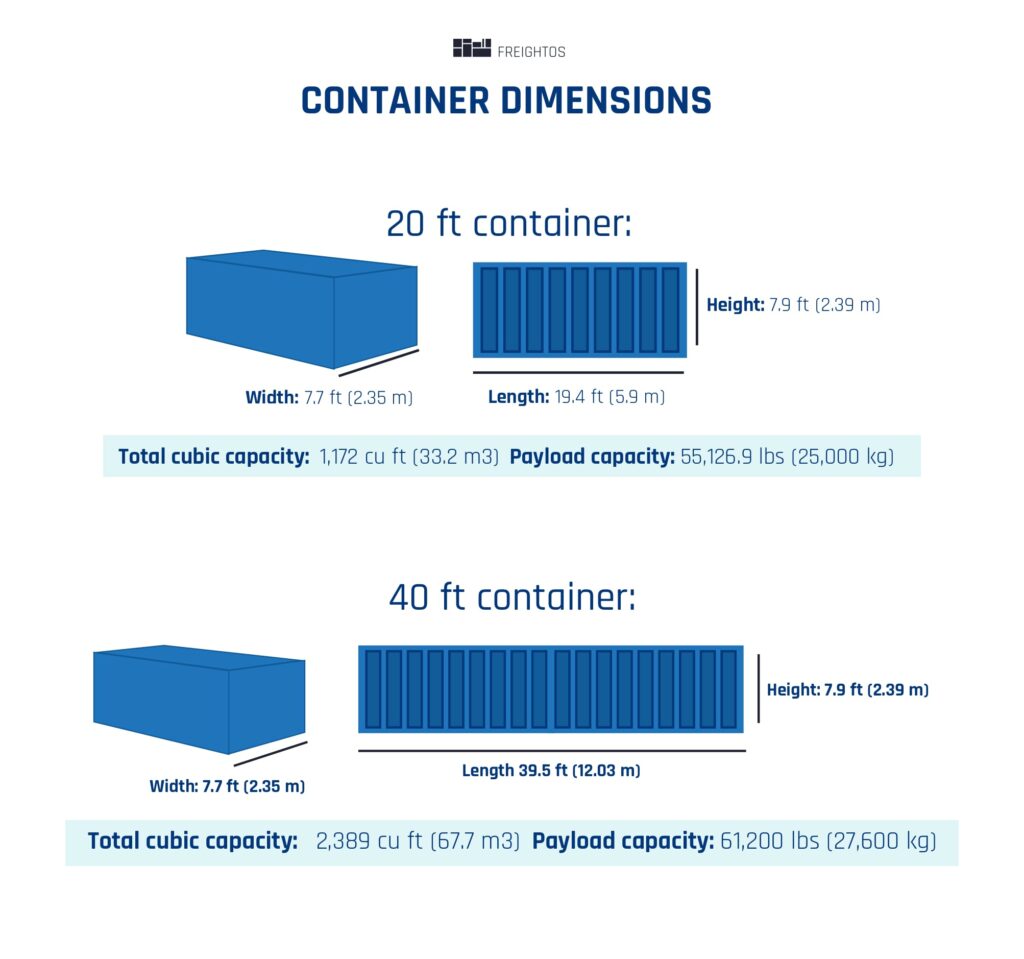
For internal dimensions, head on over to our Container Shipping Cost Calculator page. While you’re there, you can calculate your estimated shipping costs.
1 TEU & FEU
A TEU is another name for a 20ft container– it stands for a twenty-foot equivalent unit.
A FEU is another name for a 40ft container– it stands for a forty-foot equivalent unit.
- Because Freightos.com is a marketplace, you’ll be able to choose from a variety of quotes in real-time. That means you won’t need to play phone tag with freight forwarders, and you’ll get a picture of market rates at a glance.
- You can order insurance and customs clearance for your shipment while you book your freight.
- You’ll be able to track your shipment right on the Freightos.com platform.
- You’ll get support for any questions that arise.
